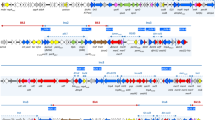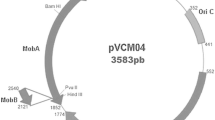Abstract
Two small plasmids fromSelenomonas ruminantium strain 19D were cloned inEscherichia coli and completely characterized. Sequence comparison indicated that the plasmids are similar to those reported in genetically vaguely relatedS. ruminantium strain S20. Small 1.4-kb plasmids pSRD191 and pONE430 are only distantly related (≈30 % for deduced Rep protein amino acid sequence) but possess a short highly conserved region outsiderep gene. Larger plasmids pSRD192 and pONE429 possess large identical DNA regions in an otherwise dissimilar background. Recombination is proposed as an important mechanism of evolution and spreading ofS. ruminantium plasmids.
Similar content being viewed by others
References
Actis L.A., Tolmasky M.E., Crosa J.H.: Bacterial plasmids: replication of extrachromosomal genetic elements encoding resistance to antimicrobial compounds.Front.Biosci. 3, 43–62 (1998).
Altschul S.F., Gish W., Myers E.W., Lipman D.J.: Basic local alignment search tool.J.Mol.Biol. 215, 403–410 (1990).
Birnboim H.C., Dolly J.: A rapid alkaline lysis procedure for screening recombinant plasmid DNA.Nucl.Acids Res. 7, 1515–1523 (1979).
Caldwell D.R., Bryant M.P.: Medium without rumen fluid for nonselective enumeration and isolation of rumen bacteria.Appl.Microbiol. 14, 794–801 (1966).
Clark B., Holms W.H.: Control of the sequential utilization of glucose and fructose byEscherichia coli.J.Gen.Microbiol. 95, 191–201 (1976).
Fliegerová K., Pažoutová S., Pristaš P., Flint H.J.: Highly conserved DNA sequence present in small plasmids fromSelenomonas ruminantium.Plasmid 44, 94–99 (2000).
Frazer K.A., Pachter L., Poliakov A., Rubin E.M., Dubchak I.: VISTA: computational tools for comparative genomics.Nucl. Acids Res. 32 (Web Server issue), W273-W279 (2004).
Hall T.A.: BioEdit: a user-friendly biological sequence alignment editor and analysis program for Windows 95/98/NT.Nucl.Acids Symp.Ser. 41, 95–98 (1999).
Holdeman L.V., Cato E.P., Moore W.E.C.:Anaerobe Laboratory Manual, 4th ed., pp. 117–123. Virginia Polytechnic Institute and State University, Blackburg (USA) 1977.
Martin S.A., Dean R.G.: Characterization of a plasmid from ruminal bacteriaSelenomonas ruminantium.Appl.Environ.Microbiol. 55, 3035–3038 (1989).
Nakamura M., Nagamine T., Ogata K., Tajima K., Aminov R.I., Benno Y.: Sequence analysis of small cryptic plasmids isolated fromSelenomonas ruminantium S20.Curr.Microbiol. 38, 107–112 (1999).
Piknová M., Pristaš P., Javorský P.: GATC-specific restriction-modification systems in ruminal bacteria.Folia Microbiol. 49, 191–193 (2004).
Pospiech A., Neumann B.: A versatile quick-prep of genomic DNA from Gram-positive bacteria.Trends Genet. 11, 217 (1995).
Pristaš P., Vanát I., Javorský P.: Variability of endonucleolytic activity indicates high genetic diversity within the natural population ofSelenomonas ruminantium.Folia Microbiol. 42, 121–125 (1997).
del Solar G., Giraldo R., Ruiz-Echevarria M.J., Espinosa M., Diaz-Orejas R.: Replication and control of circular bacterial plasmids.Microbiol.Mol.Biol.Rev. 62, 434–464 (1998).
Šprincová A., Javorský P., Pristaš P.: pSRD191, a new member of RepL replicating plasmid family fromSelenomonas ruminantium.Plasmid 54, 39–47 (2005).
Weisburg W.G., Barns S.M., Pelletier D.A., Lane D.J.: 16S ribosomal DNA amplification for phylogenetic study.J.Bacteriol. 173, 697–703 (1991).
Xiao J., Melton R.E., Kieser T.: High-frequency homologous plasmid-plasmid recombination coupled with conjugation of plasmid SCP2* inStreptomyces.Mol.Microbiol. 14, 547–555 (1994).
Author information
Authors and Affiliations
Additional information
This work was supported bySlovak Grant Agencies VEGA (grant no. 2/5140/25) and theSlovak Science and Technology Assistance Agency (grant no. APVT 5101 2602).
Rights and permissions
About this article
Cite this article
Ivan, J., Šprincová, A., Javorský, P. et al. Spreading and mutability ofSelenomonas ruminantium plasmids. Folia Microbiol 51, 283–285 (2006). https://doi.org/10.1007/BF02931814
Received:
Revised:
Issue Date:
DOI: https://doi.org/10.1007/BF02931814




